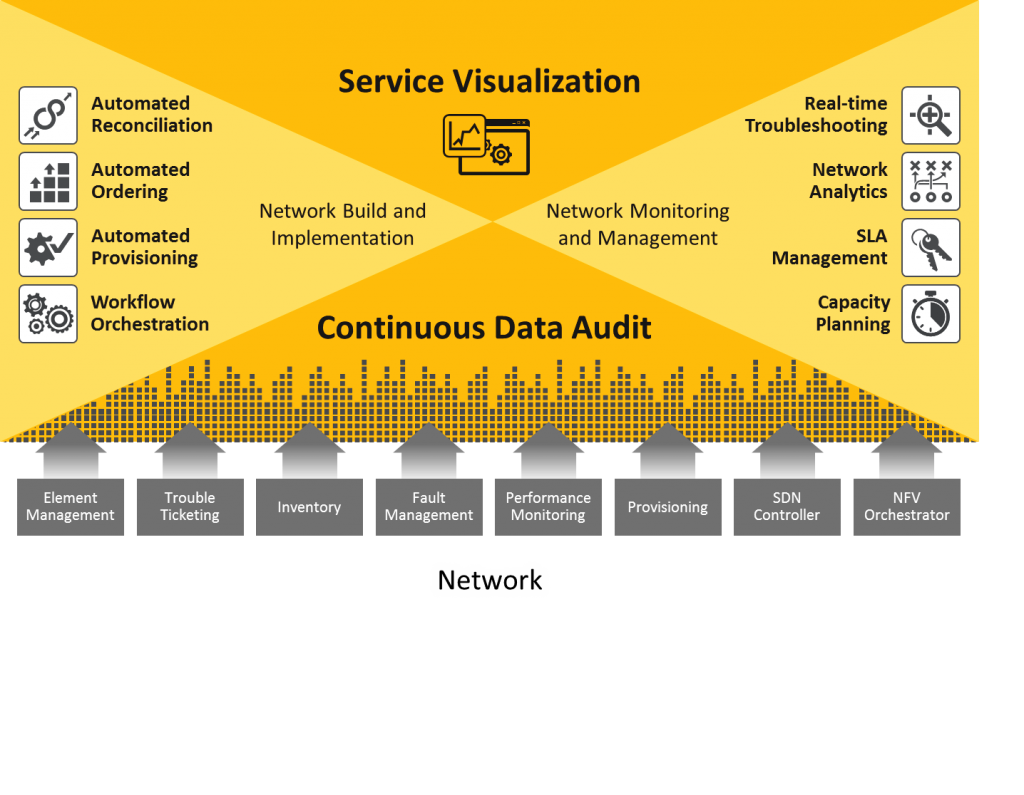This Industry Viewpoint was authored by Chris Purdy, CTO of CENX.
The convergence of LTE, Cloud, SDN and NFV promises dynamic, assured and differentiated services over efficient, orchestrated, and interconnected networks. This, the MEF’s Third Network vision, demands end-to-end Service Orchestration – and this is how it works.
Hello World!
A simple statement, and yet it is shorthand for an immensely complex process that begins fingers reaching out to hold down the shift key and tap the “H” key. Even that statement is just shorthand for a cascade of millions of neural events involving visual feedback guiding the activation of thousands of muscle cells co-operating to provide a precise physical action…
So how can I ever write a word without going crazy at all the complexity? Because tapping the “H” key was an automatic motor response, learned before I could even walk. Knowing which key to tap came later: learning to write at kindergarten. My decision to begin with that particular sentence reflected a later layer of learning – how to illustrate complex ideas by analogy. This layered abstraction of the human mind evolved over many millions of years, but computer science achieved something similar in just seven decades.
In computing terms, we see layered abstraction in the distinction between 1) hardware, 2) operating systems and 3) software applications: so that each computing layer can innovate without impacting layers above or below.
In networking and telecom operations, however, we still work in functional silos – for example we have separate inventory, provisioning performance and fault management systems. Each such functional system must hold detailed information of all network domains – like Optical, Ethernet or IP (see Fig 1). A change in any one domain would require changes in all systems – and that takes extraordinary effort, time and money – as if I had to re-wire my neurons for every single keystroke.
The Third Network
MEF has recently announced its new vision: a Third Network to deliver business-class connectivity as a ubiquitous, on-demand service – rather than as a laborious and lengthy installation and commissioning process.
While Carrier Ethernet offers outstanding service quality, performance and security to the enterprise, establishing this business class service can take weeks or months ¬– especially if the connection spans more than one service provider. But for the home or mobile worker, reliant on the Internet, their service is ubiquitous, immediate and on-demand – but it falls far short on quality, performance and security. The THIRD network promises the best of both those worlds.


The vital role of Service Orchestration
End-to-end Service Orchestration manages the entire lifecycle of connectivity services: Fulfilment, Control, Performance, Assurance, Usage, and Analytics. It holds detailed service inventory of all services in a layer or domain, providing the necessary APIs for information exchange between service providers and internal systems operating at other layers. It can be compared to those layers of intelligence in my brain that not only manage the automatic processes of body maintenance and immunity against disease, but also higher, learned skills like language, as well as critical decision making.
To illustrate how this works, consider the Cortx Service Orchestrator launched by CENX in September 2014. This product consists of a set of software modules that can be integrated within an existing network operation, utilizing open APIs to interface with existing systems. Cortx has been specifically designed to support multi-layered network domains, and new technologies such as NFV and SDN, so it need only know and enforce the service level parameters, not how the service is implemented.
How does the brain manage complex physical actions? The first requirement must be continuous input from every nerve ending and sensory organ across the body: I can only move my finger to the “H” key if I know the position of myself and my finger, and can see where the target key is.
So the first essential Cortx function is Continuous Data Audit, to receive data from multiple sources right across the network – including OSS and test equipment. Just as in the brain, this would amount to a torrent of data that would overwhelm any legacy management system, but this system uses big data analytics to make sense of it. So the second essential function is Service Visualization: shaping this torrent of data into meaningful information by presenting it as a geographical or topological map revealing the end-to-end circuit path topology for on-net and off-net circuits and presenting a monitoring dashboard that includes status of network build (ENNIs, EVCs, UNIs), and the inventory, performance, and fault states of Ethernet and other connections.
The brain does something similar: presenting a torrent of nerve impulses from the optic nerve as a recognisable “H” key, towards which I can then direct my finger.
Once those two essential functions are satisfied, then any number of extra solution modules can be added as your needs evolve beyond inventory integrity assurance, to network build-out and implementation, and to end-to-end performance monitoring and management.
Already available for Network Monitoring and Management are:
• Real-Time Troubleshooting – displaying near real-time state and monitoring data and isolating faults to the root cause. This reduces MTTR and truck rolls, and helps determine fault responsibility between SP networks.
• Network Analytics – planning network capacity and managing CAPEX with superior reporting to allow just in time upgrades.
• SLA Management – allowing service providers to manage SLA parameters as across multiple access vendors, and helping enterprises with visualization of near real-time performance metrics, and reporting.
• Capacity Planning – providing fine-grained measurement of capacity, utilization, and performance in order to pinpoint where service is degrading and automating the capacity upgrade process. This reduces the CAPEX and OPEX for upgrades.
To support Network Build and Implementation there are further modules:
• Automated Reconciliation – re-populates inventory systems with clean data, and re-provisions network equipment to match inventory data, ensuring trustworthy data across the network.
• Automated Ordering – translates order processes and formats between providers and customers, exchange tenants and access vendors. This reduces order fall-out and accelerates time to market.
• Automated Provisioning – automatically configures network equipment functions, such as port selection, bandwidth, and service type, to initiate service provisioning. This improves the accuracy of network services provisioning and reduces fall-out.
• Workflow Orchestration – coordinates workflows for full lifecycle of each service, triggering other modules, tracking workflow analytics in a dashboard. This reduces service delivery intervals and operational cost due to automation.
Figure 3 summarizes these currently available modules and their potential applications.

Service Orchestration in practice
Today’s soaring data usage and high service expectations mean that providers must deploy their services ever more flexibly, quickly and with impressive quality from day one. This can only be achieved by Service Orchestration – automating the entire lifecycle of service ordering, provisioning, implementation, analytics, and assurance.
Just as there are no limits to the potential of an intelligent brain: so there are no limits to the number of ways that Service Orchestration can help cloud providers, service providers, large enterprises and anyone responsible for large, complex networks. So one example will be given – Fig 4.

This graph illustrates the increase in actual bandwidth demand for a mobile operator over six years (pale green) and the general estimate of bandwidth demand for an average cell site (straight red line).
Until now it has been necessary to plan for a major upgrade every three years, and this requires (black line) a huge margin of extra provisioning to allow for unexpected variations as well as the anticipated increase. There are many reasons for this, such as:
• Legacy leased line backhaul requires physical installation and cannot offer granular bandwidth increases;
• Lack of the sort of detailed data and analytics provided by Cortx means “just in case” provisioning with a wide margin for error
• Lack of automation in the upgrade process requires considerable forward planning and a lot of manual labour.
Service Orchestration makes it possible to upgrade more flexibly as well as more accurately. In this example we have simply increased the upgrade cycle from three years to one year (dark green line) to show a massive saving. “Wasted bandwidth” is shown as the blue striped area between the step-changed bandwidth and the actual light green bandwidth requirement – and the area of waste under the black line is vastly greater than that under the dark green line. What’s more, further savings could be made by reducing the upgrade cycle to six months or less.
Conclusion
This article can offer only a glimpse of the potential benefits of end-to-end Service Orchestration – not only to deliver immediate improvements in visualizing, management agility and upgrade times for existing networks, but also to support migration to tomorrow’s NFV and SDN innovations.
As Glen Ragoonanan, Principal Analyst at Analysys Mason, points out: “SDN and NFV adoption is being inhibited by a lack of standards and immaturity of OSS, policy-based controller products that can integrate with operators’ existing environments”. Cortx is filling that gap by providing the performance and elasticity needed for NFV, network scalability and real-time big data analytics, while its open REST APIs allow faster integration for SDN controllers and NFV management.
NFV and SDN are key to the Third network future and its promises of lower CapEx and operating costs, as well as service potential and agility, but they demand a fundamentally new approach to managing network services – one that orchestrates services top-down, across both physical and virtualized infrastructures, across multiple vendors, and across multiple carriers.
If you haven't already, please take our Reader Survey! Just 3 questions to help us better understand who is reading Telecom Ramblings so we can serve you better!
Categories: Ethernet · Industry Viewpoint · SDN






The telephone call is still the first mode of contact between a business and a potential client in numerous occurrences. This implies that having a solid, cutting edge PBX framework is an essential and imperative choice for any association. As innovation has propelled we have gone from simple trades to advanced and virtual frameworks, it implies that picking your optimal telephone framework arrangement is getting to be progressively troublesome.